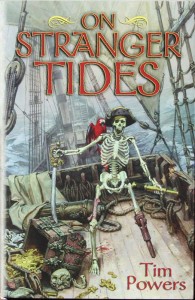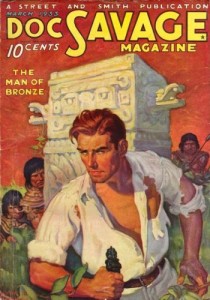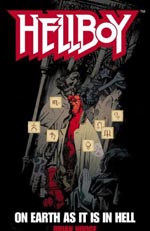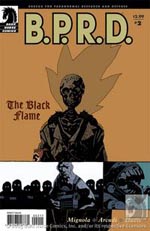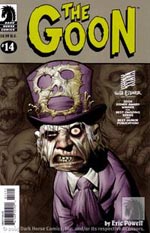Yes, susurrus was Dictionary.com’s word of the day a few days ago–and yes, I pull more than a few of these entry from that website–but this one is particularly apt, as autumn has arrived here in New England.
I love autumn in New England. It’s not just beautiful, it’s sublime. The cold, crisp air; the multicolored trees; the swishing sound of feet moving through fallen leaves. I feel a surge of happiness, tied closely to memory, when I walk down a New England sidewalk in the fall; the sunlight filtering through leaves of orange and yellow, a soft breeze against my cheek.
Winters are cold and windy here; spring is wet and often miserable; summer is humid and miserable. I accept this, grudgingly. But from September to the end of December, New England is my favorite place on earth.
With that bit of attempted poeticism out of the way, on to some comic reviews. Note: My “reviews” aren’t so much reviews as they are discussions of the comics, so if you don’t want spoilers, don’t read the review.
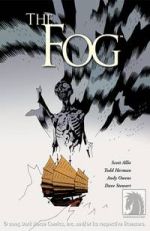
The Fog
Click here to order
I gave The Fog remake a middling review in my last post, but I was doggedly determined to find something of worth in the franchise. As such, I picked up writer Scott Allie’s graphic novel. The cover drawn by Mike Mignola was a big incentive for the purchase, but I felt there must be something to this Fog deal, and that perhaps the relative creative freedom of a graphic novel would validate that suspicion. And it does, to a degree.
Allie’s Fog is a prequel of sorts to the new film, though as Allie points out in his afterword, it can serve equally well as a prequel to the original John Carpenter film. The story involves a group of Chinese immigrants living on the coast of America (I wasn’t clear where–I think it was somewhere in the antebellum South) in the mid-1800s. Amid growing tensions between the immigrants, the rich landowner who employs them, and the landowner’s sadistic half-brother, a mysterious curse comes back to the haunt the Chinese refugees; a curse involving–you guessed it–fog.
The comic is well drawn by Todd Herman and colored by the inimitable Dave Stewart. However, Stewart attempts a strange sort of effect to create the sense of fog–it’s difficult to describe; almost like the vestiges of a watermark on a light gray background. I don’t think it quite works, and ultimately I was more interested in Mignola’s idiosyncratic depiction of fog on the cover than the one in the book.

BPRD: The Black Flame #3 (of 6)
Click here to order
This issue made me realize that events in the “Hellboyverse,” for lack of a better term, are moving really fast–perhaps too fast. Between the hints given in “The Island” (see this entry) and the current story in BPRD, there will be an apocalyptic reckoning relatively soon. In fact, unless Mignola decides to really drag it out, I can see Hellboy’s story being over within ten years.
The world of Hellboy was always a bit of an parallel universe. In the comic (unlike the film adaptation) Hellboy is a public figure; everyone knows who he is and what he does and who he works for, and consequently, everyone knows the supernatural exists.
But it’s still a very similar world to ours–people know the supernatural exists, but they try to ignore it. When the plots of the Hellboy comics remained fairly small in scope, it was easy to identify with Hellboy’s world. But events in this and upcoming issues of BPRD make it clear that our world and the world of the BPRD are diverging.
Personally, I don’t like this. I’m not making a distinction of quality between stories set in “our” world and stories set in alternate universes–alternate universes aren’t “bad”–but I prefer it when I can imagine these characters (and monsters) existing in my own universe.
Then there’s the “End of the World” scenario playing out in this story arc. I think it’s a shame Mignola and Dark Horse decided to go with miniseries rather than a continuing BPRD comic. Unlike Hellboy’s solo adventures, I think BPRD would have been perfect as a sort of comic version of The X-Files, with atmospheric standalone stories and single-issue character studies mixed in among the greater “mythos” storyline.
Between “The Island” and BPRD, I have no idea what Mignola sort of universe Mignola is creating. To elaborate: I was reading some comments by S.T. Joshi last night about H.P. Lovecraft’s novella At the Mountains of Madness. Joshi claims that in this story, Lovecraft “demythologizes” all his previous tales; i.e., he “retcons” all his earlier supernatural fiction (which often involved witches, ghouls, and vast dreamscapes) to fit the rules of “science,” or rather, materialism. Essentially, all that macabre stuff suddenly became the result of humanity brushing up against other dimensions and the inconceivable entities that thrive therein. God and the Devil as sources of the supernatural were exchanged for “science” and extraterrestrials.
According to comments made by Mignola and his editor, Fog-writer Scott Allie, there was a general decision to move the post-BPRD Hellboy, in his solo adventures, away from the “Lovecraftian” conception of the supernatural that ran through much of the comic and into the realm of folklore, while the BPRD continued to develop the eldritch side of the Hellboy mythos. So far there’s still quite a bit of crossover, particularly in “The Island,” though that story may represent the end of Hellboy’s involvement in the Lovecraftian world for now.
In an interview, Mignola said,
“The whole first chunk of the Hellboy adventures is about avoiding having any kind of mission in life, other than ‘Yeah, my job is to fight monsters.’ What the next chapter of Hellboy ends up being about is, you have a very specific mission – a very specific goal. And this first chapter has been a lot of Lovecraft kind of stuff. We’ve introduced the folklore elements, [and] my own kind of Lovecraft mythology that is being dealt with in the BPRD. This new chapter of Hellboy is very, very folklore-oriented. So this story, in a way, is me making my big statement about the kind of fake ‘Lovecraftian’ mythology [featured in Hellboy to this point].”
Mignola appears to be trying to have it both ways–the mystical supernatural world of folklore and the materialistic mileau of Lovecraft. Hellboy lives in the one, and the BPRD in the other.
I can’t decide whether I think mixing these two conceptions of the preternatural is smart or sloppy. I suspect it was something Mignola wasn’t too worried about initially; and if I had to guess, I’d say Mignola is more interested in the folklore than the Lovecraft stuff, and we may owe as much of Hellboy’s Lovecraftian themes to John Byrne’s involvement in the first Hellboy graphic novel (Seed of Destruction) as to Mignola’s own tastes.
In think it’s that “demythologizing” (or perhaps “scientificizing”) aspect that draws me to Lovecraft and originally drew me to Hellboy (or rather, to the film, which I saw before reading the comic). I liked the notion of this traditional red-skinned devil creature being explained as a creature of another dimension or universe.
Many of my favorite Lovecraft stories, such as At the Mountains of Madness, “The Dreams in the Witch-House,” and “The Call of Cthulhu,” feature this use of scientific principles to “explain” ancient superstitions and supernatural phenomena. For a twentieth-century, post-Relativity reader, it’s the perfect way to create at least the veneer of reality necessary to believe any of the creepy things in Lovecraft’s tales are possible.
Mignola never seemed interested in going that route. In its early years Hellboy, like The X-Files, veered constantly between science fiction, folklore, religion, and the mystic supernatural, with no unifying thread tying them all together. Lovecraft may not, as purists claim, have created a true “mythos,” but in his later work he did create a kind of logos, a unifying principle of the world, in which humanity is insignificant and the earth and its intergalactic brethren are tossed about by incomprehensible cosmic forces like leaves in a storm.
That’s what I enjoy about Lovecraft, and it’s what I enjoyed so much in the Hellboy movie. It’s there in the comics, too, but it came to a head in the graphic novel Conqueror Worm, and by Mignola’s own admission, it’s not the direction Hellboy (in his solo adventures) will be going anymore.
But I don’t really mind that. I love Hellboy and will continue to read the comics with pleasure. Most writers can look at someone else’s work, even that of their favorite authors, and say, “This is great, but it isn’t quite how I’d do it…” The world of Hellboy belongs to Mignola, and I accept that. Mike’s one of the best comic artists out there and a true heir to the writers of the Weird Tales era.
Getting back to the issue at hand (pun intended), BPRD has been pretty securely anchored in the Lovecraftian side of the Hellboy mythos, and The Black Flame #3 is no exception. Zinco, the evil corporation of the Hellboyverse, continues its Nazi-like melding of the scientific and the occult, while its manager Pope goes insane.
The big news in this issue is that Roger, the human-sized homunculus much loved by fans, is dead, blown to smithereens by the Black Flame (a.k.a. Pope). The last sequence of panels zoom in on Roger’s circular “gas cap” which he uses to power up, and the upcoming cover to Black Flame #6 features the little ancient Native American knob or dial that Roger came across in–well, I’m not sure what issue it was. But I’m wondering whether that dial fits into Roger’s gas cap.
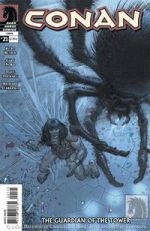
Conan #21
Click here to order
The second part of the “Tower of the Elephant” storyline continues as Conan and the Rubenesque master thief Taurus enter the eponymous structure.
I’m impressed that writer Kurt Busiek was able to spread this story over three issues. I also think it should have been two at most. I’ve also never warmed to Cary Nord’s art, but I still enjoy seeing my favorite Cimmerian in action.
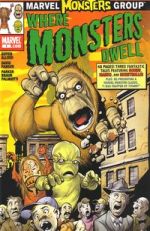
Marvel Monsters: Where Monsters Dwell
Click here to order
The second in the Marvel Monsters series and probably the last one I’ll buy. This one features three new stories and one reprint.
The first story, “Bring on the Bombu,” writ by the oft-amusing Mike Allred and drawn in retro-60s style, features the laughable monster of the original 1960 short “Bombu: the Witch Man,” who is in fact an alien, not a witch doctor. In an attempt to gain credibility among the natives of Earth, he threatens New York with his weapons of mass destructions, which he calls “Ting Tang” and “Wallah Wallah Bing Bang.” As you might predict, the story ends in tears for poor Bombu.
“The Return of Monstrollo” is a Hollywood parody by Peter David, in which the hero of the original 1960s tale finds himself destitute in La-La-land and in need of a helping hand–which he gets in the form of aliens and a reanimated Monstrollo himself.
Then there’s “The Shadow of Manoo” by Jeff Parker, which features a more subtle and disturbing kind of humor than the previous stories, with a surprise if not entirely believable ending.
Finally, the last story is a reprint of a Joe Sinnott/Jack Kirby story, “I was Trapped by Titano!”, featuring a colossal lobster. The story is brief and more interesting than the one from “Devil Dinosaur.”
Oh, one final note, the cover is draw by Eric Powell of–
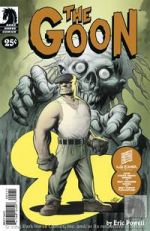
The Goon 25¢ issue
Click here to order
—The Goon fame. In an effort to boost sales, Dark Horse has released this reprint of an early Goon story, one that serves as a pretty good introduction to the character and the comic. Selling for just 25¢, it also features a brand-new back-up story starring the Unholy Bastards, Powell’s answer to the Little Rascals.
As a missionary of the Word of Powell, I bought a bunch of issues of this comic, and I will send a copy–free of charge!–to the first four (4) people who email me and ask nicely.

Mr. T #2
In the interests of full disclosure, I will include this in my list of comic reviews. Yes, I’m reading the Mr. T comic. No, it’s not that bad; yes, it’s not that great.
In this issue, Mr. T beats up some drug dealers and goes after the Head Honcho of the dealers, where he meets his match–a ‘roided up thug named Stare Roy. Yes, Stare Roy. No, it’s not Jason Giambi.
—-
Phew. The discussion of The Black Flame #3 alone is longer than many whole entries I’ve written for this thing.
I hope you’ve enjoyed these lengthy reviews of comic books you probably don’t read, but in the case of at least BPRD and The Goon, you should. For those of you who don’t like to buy individual comics, you can always buy the trade paperbacks–Dark Horse has tons of ’em.
